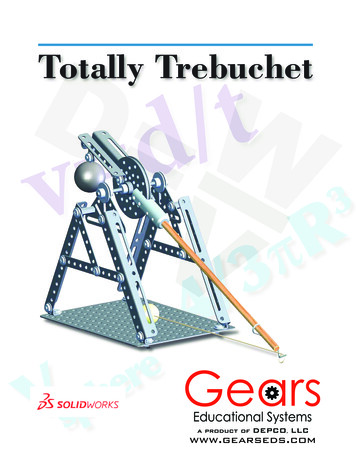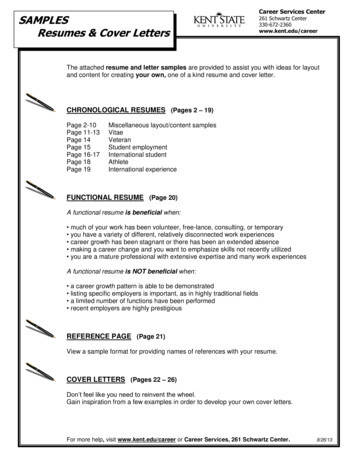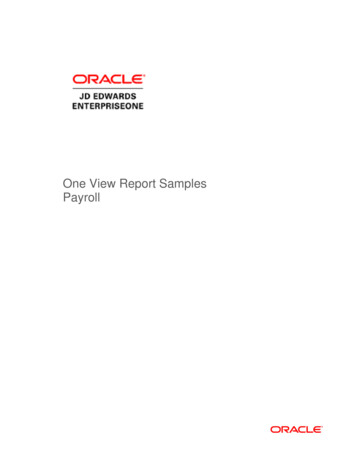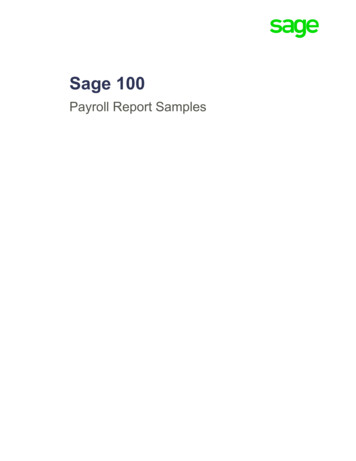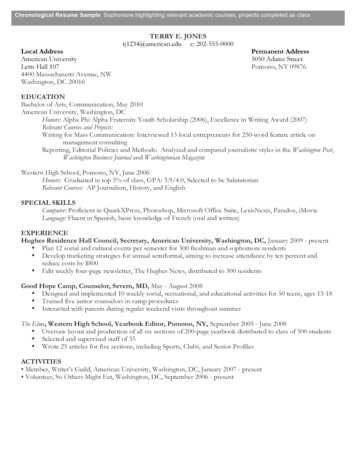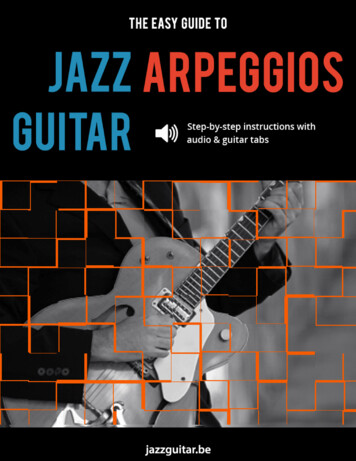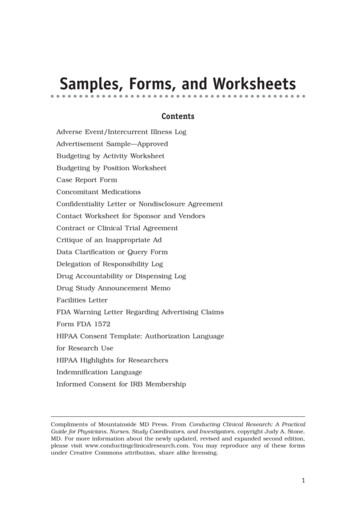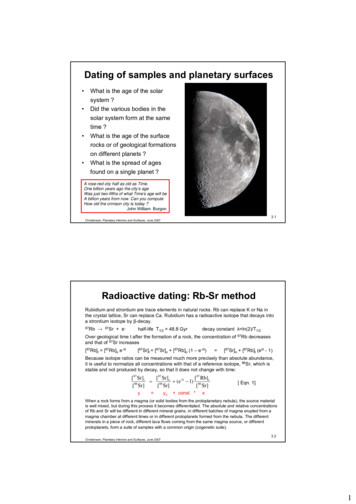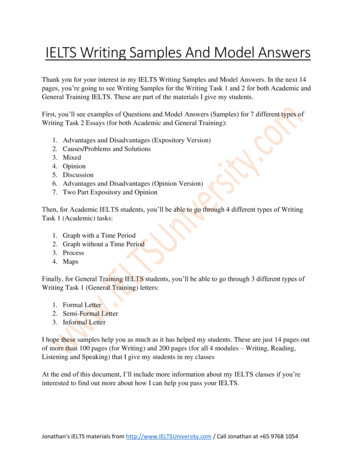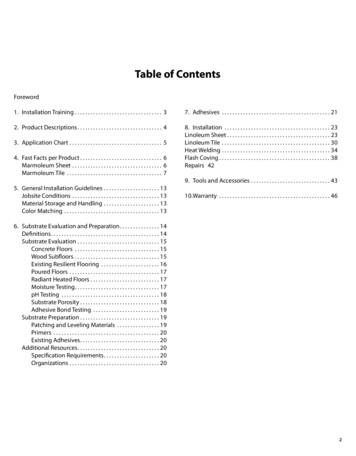
Transcription
Center for Research and OutreachCollege of Education, New Mexico State Universityhttp://cro.nmsu.edu/proposals.htmlGrant Proposals—Template with SamplesPurposeWhile no two grant proposals look exactly the same, they do follow a general structure ortemplate. We created these pages to assist those new to grant-writing, but also as a resource forthose familiar with grants but seeking new ideas.Remember, no perfect formula or (set of formulae) exists for every grant situation. It is importantto understand the type of project the agency wants to fund. For my students, we call this“Learning to Love Your RFP” (Request for Proposal). Then use the examples we have provided thatbest fit your grant and your funding agency.We hope our templates with samples help you in your endeavor.Listed Below (with samples)Project Abstracts/Summaries:Sample Research AbstractSample Abstract/Summary for Service Grant1.2.3.4.5.6.7.8.IntroductionNeeds AssessmentRationale/Theoretical FrameworkResearch DesignWork Plan/Action Plan/Scope of WorkEvaluation PlanManagement PlanOther documents for grantsa. Letters of Support samples
Center for Research and OutreachCollege of Education, New Mexico State ct for a Research GrantSample #1Using Media to Help Students Learn MathematicsProject SummaryThis Research and Development project addresses a Research-K12 Program Challenge 2: How can all students learnsignificant STEM content? The project focuses on developing educational media to aid students in understanding coremathematics concepts that researchers have found are misunderstood as students reach middle school. The project willalso provide instructional tools to assist teachers in using these media, and thus secondarily addresses K12 ResearchProgram Challenge 3: How can teachers teach STEM content?In spite of general gains in mathematics learning in the United States (NAEP, 2007) and successful mathematicsprogress for students in many of the math reform efforts, (MSP Impact Report, 2008), researchers have noticed criticalgaps in conceptual understanding of core mathematics concepts and processes in students. These misunderstandingscause problems for students as they move through school. By high school, achievement scores drop dramatically, andthe gap in test scores between mainstream and culturally and linguistically diverse students can be as much as 30 points(NAEP, 2007). Our research question is: In what ways can innovative media be used to help students learnsignificant mathematics content? Designed by mathematics educators, mathematicians, learning specialists and gamedevelopers, the media in this proposed project are organized around math concepts that are often misunderstood. TheMath Project modules are meant to be easy to access and use, focused on one concept at a time. They provide richnourishment for the middle-grades curriculum. The project focuses on math concepts, that for some reason, studentshave found hard to master using a traditional text-based mathematics curriculum. Funny scenarios, comical characters,and memorable vocabulary are used to help students see mathematics as entertaining as well as understandable.Intellectual Merit: Researchers, while conducting evaluations of student performance within successful mathematicsprojects in New Mexico (NM), found that there were consistent weaknesses in understanding in specific areas ofmathematics across schools by grade levels. Further research demonstrated that these same areas of weaknesses couldbe found across states. If these small media modules can help schools and teachers provide quick and useful interactivelessons from which students can learn previously misunderstood math concepts, the product will be of significant valuenationwide. Extensive research is planned in this project, beginning with an iterative design process including teachersand middle-school students and continuing with randomized controlled trials in school classrooms.Broadened Participation; Research will specify how well these materials work for all students, as well as for whichgroups they seem to work best. Developing and researching the materials in New Mexico, a lab for the future of ourincreasingly diverse classrooms, will ensure the products will be useful as we move math education into the future.Throughout the project, team members will evaluate materials for potential use by English language learners, adultlearners, and other learners not in the specific audience targeted in development.Sample #2Make-IT! is an inquiry-based, information technology (IT) program that involves under-represented girls in grades 712, their teachers and their parents in using e-portfolios and digital media to develop their abilities in STEM fields. Theproject models SCANS competencies for workplace know-how in the 21st Century and leverages the resources,programming, and community-based projects of a successful mathematics, science and IT collaborative in the southwestborder region. Make-IT! will enhance life-long application of information technology to STEM learning in a year-round
Center for Research and OutreachCollege of Education, New Mexico State ic enrichment program that includes an after-school component, monthly Saturday all-day symposiums, and amonth-long summer field-based experience.The intellectual merit of this research effort resides in using and practicing information technologies as a means forunder-represented students to learn about STEM careers and gain IT abilities. Following weekend and after-schoolexplorations, a university field-based summer lab experience supports students in an intensive experience culminating inthe development of a personal STEM e-portfolio. The project also brings together university experts in science andinformation technology with public school and community leaders to deliver a systemic, focused, year-roundenrichment model.The broader impact of the project is the development of a model that uses information technology to supportlinguistically and culturally diverse girls in applying 21 st century workforce know-how to their own development asfuture STEM leaders. The development of an extended-day community-based learning model that results in moreunder-represented students entering STEM fields is essential for the economic well-being of the border region.Abstract for a Service GrantSample #1NEW MEXICO TEACH MATH AND SCIENCE PROGRAM!Submitted by New Mexico State UniversityAs a minority-majority state with a high rate of poverty and low educational achievement, NewMexico is experiencing a critical need for highly qualified math and science teachers. This proposalbrings together research universities, educational consortia, and 24 school districts with high needsto address this need through an innovative teacher preparation program and nested professionaldevelopment experiences.Program goals include utilizing and strengthening existing STEM partnerships to recruit, train, andretain 40 new math and science secondary (grades 6-12) teachers each year for a period of 5 years.At the end of the program, the components will be institutionalized and a total of 200 new teacherswill have been placed in the 20 partner school districts. Program outcomes will include 200 newteachers who are prepared to serve the diverse and high needs population of New Mexico;understand best practices in math and science instructional methodology; are committed to the fieldof education; and bring a diversity of backgrounds and experience to their work. Moreover, thisstatewide program will attract continuing support beyond the grant period.Program participants will hold a bachelor’s degree in science, math, or engineering and will earnalternative licensure to teach math and science. They will participate in coursework over twosummers, one fall semester, and one spring semester during their first year of teaching. Mentorswill be work with individual participants throughout the program, and, for the second and thirdyears, the participants will join the Scientifically and/or Mathematically Connected Communities(state STEM programs) to participate in monthly professional development opportunities as well as
Center for Research and OutreachCollege of Education, New Mexico State g summer workshops. In subsequent years, science/math field specialists will continue thementoring through team teaching, demonstration lessons, lesson design, and other activitiesrequested by the participants or identified through program assessment.INTRODUCTIONThe introduction should hook the reader. It should motivate the reader to spend his/her time inreading forward. Why should this grant proposal interest the reader? What problems areaddressed and why are they important? What are your goals and objectives? What is your capacityto implement change?In sum, the Introduction:Is designed to hook the readerIncludes an overview of:o The purpose of the grant in addressing a specific needo The grants broader goals (and often outlined objectives) of the granto Your own program’s capacity to study or implement a solutionSample #1Why a Student BUILDING program is needed in Target, New MexicoIn 2006, there was a major flood in the small town of Target, New Mexico. The population of thetown at the time was around 1200 and is now closer to 900. This flood, Federal EmergencyManagement Agency (FEMA) Disaster #1234 5 (Target, NM) was in many ways, New Mexico’sKatrina. The flood damaged or destroyed 55 of the town’s 80 businesses, and adversely impacted402 of 480 residential dwellings. Now over two years later, approximately thirty families are stilldisplaced from their homes and live in FEMA trailers 10 miles away in Neighboring Town, NM.The flood left behind a severely damagedinfrastructure. According to the Target AreaRecovery Team, 95% of residents did not haveflood insurance (REFERENCE NAME, 2009).There is also a shortage of trained adobe andearthen structure workers in the area,
Center for Research and OutreachCollege of Education, New Mexico State ularly those experienced in basal (wall base) stabilization and in the application of traditional(mud and lime) plasters. Contrary to unofficial assessment by regional general contractors andsome building inspectors, almost every building assessed by the Desert State University (DSU) andCornerstone staffs, whether they are adobe, masonry, or of frame construction, can and should berepaired. In other words, rehabilitating existing structures is not only more cost-efficient, butpreserves the historical equity of buildings and homes of the area.The community of Target, other community organizations in Our County, as well as Desert StateUniversity’s Colleges of Education and Engineering and Our County Community College (OCCC)have come together to prepare this grant proposal. They see in YOUTH RECONSTRUCTIONprogram an innovative means to offering hope and resources to solve two problems: theunemployed, underemployed and under-educated youth in Target and the surrounding ruralcommunity, as well as the need to help families who remain without housing and have been waitingfor help .for two years. This proposal is aimed at providing education and high wage jobs for youthwhile also alleviating a severe housing shortage and rebuilding a town.The goal of this proposal is to address the needs of Target and the surrounding rural communities.These needs will be meet by the rebuilding of these damaged homes to pass code inspection,leading to increases in the historical and property values of these homes while also providingeducational opportunities for youth leading to high-school degrees, certification in the buildingtrades, and for those who desire it an AA degree in construction through Our County CommunityCollege (DACC). At least 75% of the participants who graduate from YOUTHRECONSTRUCTION program will be either successfully transitioned to postsecondary educationor will possess a job that averages at least 10 an hour. By creating a partnership of communitydevelopment agencies, work force offices and university and community college outreach effortswithin the YOUTH RECONSTRUCTION framework, Target’s hope in its future and the future ofits youth can be restored. The YOUTH RECONSTRUCTION program also offers to youth,leadership development, academic remediation, career and post-secondary advisement, communityinvolvement, and will lead to real educational and career opportunities.
Center for Research and OutreachCollege of Education, New Mexico State Universityhttp://cro.nmsu.edu/proposals.htmlSample Introduction #2COMMUNITY LITERACY PROGRAM (CLP) TEACHER LEADER ALLIANCE (TLA)VISION, GOALS, AND OUTCOMESThe Community Literacy Program (CLP) Teacher Leader Alliance proposal responds to the need ofpartner districts across New Mexico that have embarked on full scale implementation of innovativeliteracy programs, yet lack the leadership on school campuses or in their districts to supporteffective enactment of a quality curriculum.The proposed CLP Teacher Leader Alliance (TLA) projectdesigned in partnership among English and LanguageOur Vision: Teachers who completeprofessors, education faculty, and school district leaders willthe Teacher Leader Alliancedevelop a cadre of 60 literacy teacher leaders that have a deepprogram will become intellectualconceptual knowledge of K-12 literacy, as well as theleaders able to facilitate theknowledge, skills and dispositions to facilitate growth increation of rich mathematicsliteracy teaching and learning environments in schools orlearning environments for teachersdistricts. The Alliance will provide a two year cycle ofand students in schools andprofessional development (PD) through intensive summerdistricts.study as well as a follow-up academic year program thatincludes application of their learning in their school or districtsetting. The first cycle will begin in summer 2010 and include a cohort of 30 Teaches Leadercandidates. A second Alliance will begin in summer 2012 with thirty new Teachers Leadercandidates.We begin with the end in mind, by envisioning the characteristics of our teacher leader candidates atthe completion of the proposed CLP- Teacher Leader Alliance.I. Deep Understanding of Literacy Concepts via Vertical Progression and Connections:Teacher leaders will gain a new lens for learning literacy by studying how concepts connect withinand across grade levels (vertical articulation). Teachers will gain a deeper understanding of literacyconcepts by understanding these connections. They will understand how the content progressesthroughout the K-12 continuum and how the concepts in various grade levels relate to one another.By gaining a range of models and strategies to represent literacy ideas, Teacher Leaders will be ableto help reading and literacy teachers throughout K-12 levels to differentiate their instruction andmeet the needs of diverse learners.
Center for Research and OutreachCollege of Education, New Mexico State Universityhttp://cro.nmsu.edu/proposals.htmlII. Pedagogical Practices that Represent the Art and Science of Masterful TeachingTeacher leaders will know how to listen to language, build literacy learning experiences andconversations around children’s ideas and understand how to support their learning. Specifically,they will know how to use effective teaching strategies grounded in our state’s process standards ofproblem solving, communicating, reasoning, representing, and connecting literacy and readingideas. They will be able to assess student literacy thinking to understand each student’s knowledgeframework and choose instructional moves that build upon student’s existing knowledge.III. Intellectual LeadershipTeachers will have a depth of knowledge of literacy and pedagogy and how to apply them in schoolsettings that will allow them to become intellectual leaders in their district and schools. They willhave gained dispositions, knowledge of strategies, and tools for working with adult learners andthey will have the intellectual capital to be seen as leaders in their schools or districts. TeacherLeaders will know how to facilitate cultures of learning among colleagues and administrators withina school system. They will understand and implement practices from adult learning theory tosupport teacher’s professional learning and engage in productive professional discourse. Thisintellectual leadership will lead to successful district or school-wide collaborative efforts based onflexibility in thinking and the ability to understand multiple perspectives on learning and thechallenges of teaching. Teacher Leaders will have confidence by the end of the two-year Allianceexperience to know that they can positively impact a school system at various levels.IV. Supportive School EnvironmentPrincipals will understand the research that supports improved student learning of literacy and howto foster a culture of professional learning on their campuses. Principals and Teacher Leaders willcollaboratively develop a vision for the Teacher Leader’s role on the school campus or in thedistrict. They will create formal agreements that define the scope of work of the teacher leader andthe principal’s support towards this partnership. They will clearly communicate expectations forprofessional learning among school staff and routinely engage in reflection and evaluation of theprogress the school is making towards teacher and student learning goals.Sample Introduction #3Capacity Statement:Desert State University (DSU) brings a wealth of expertise to support this effort. It is a Carnegie I Researchinstitution, and a land grant, sea grant and space grant institution located in BigTown, Desert State. It is theflagship of the Desert State University System, which consists of nine universities, eight state agencies, and ahealth science center that serves 90,000 students and reaches more than 4 million people each year. DSU hasan enrollment of approximately 44,000 students, and ranks among the top 10 universities nationally in valueof research, including support for many cutting-edge science and technology initiatives.
Center for Research and OutreachCollege of Education, New Mexico State Universityhttp://cro.nmsu.edu/proposals.htmlDSU is a national leader in developing telecommunications and is a member of the “High-Tech”Consortium. The High-Tech Consortium is led by 170 universities in partnership with industry andgovernment to develop and deploy advanced network applications and technologies. High-Tech is creating anetwork capability for the national research community to ensure the rapid transfer of new services andapplications to the broader Internet community.The DSU College of Education (3,820 students) is a leading developer of teachers in Desert State. Thecollege has 112 tenure/tenure track faculty members plus 60 additional teaching faculty members. TheCollege of Education is accredited by the National Council for Accreditation of Teacher Education, theSouthern Association of Colleges and Schools, the American Psychological Association, and the Desert StateEducation Agency. The College of Education has several centers and outreach programs, including [ProjectOutreach] which can support the proposed activities. Project Outreach assists organizations with strategicplanning for technology, maintaining, troubleshooting and upgrading technology, and using distance learningtechnologies effectively. There are state of the art technology training facilities in the College of Educationand in Project Outreach, as well as technology support personnel.Other resources that can support the proposed activities include [ANOTHER Project]. A primary task of OurProject is to link the Desert State Essential Knowledge and Skills (TEKS) objectives that are the basis fo
University’s Colleges of Education and Engineering and Our County Community College (OCCC) have come together to prepare this grant proposal. They see in YOUTH RECONSTRUCTION program an innovative means to offering hope and resources to solve two problems: the unemployed, underemployed and under-educated youth in Target and the surrounding rural

